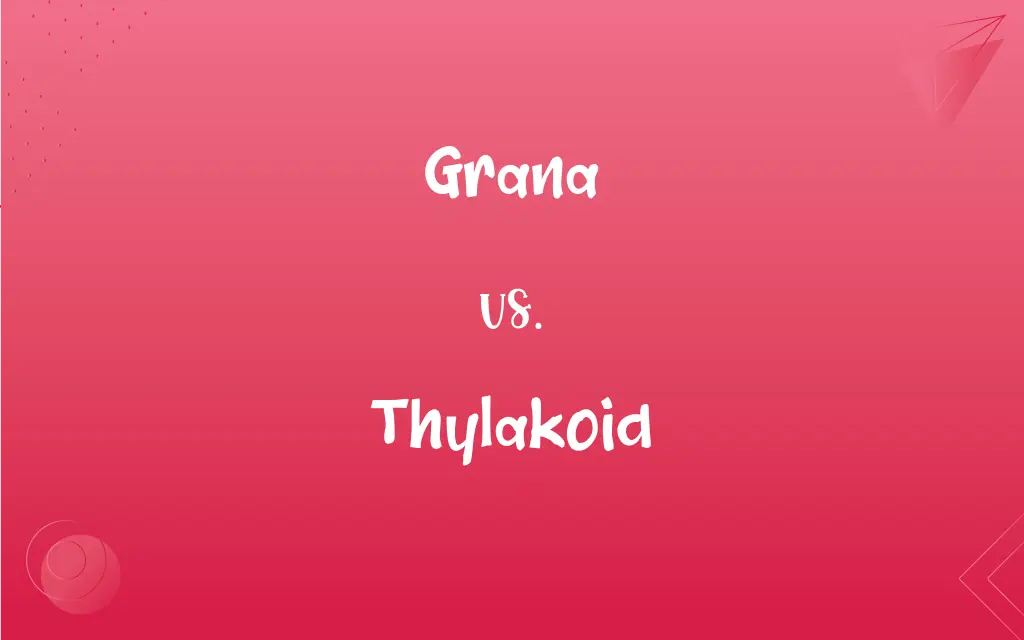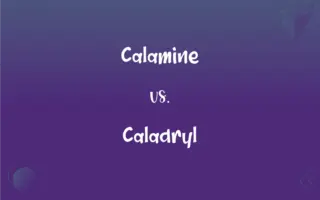Grana vs. Thylakoid: What's the Difference?
Edited by Aimie Carlson || By Janet White || Published on March 14, 2024
Grana are stacks of thylakoids within chloroplasts; thylakoids are membrane-bound compartments where photosynthesis occurs.

Key Differences
Grana and thylakoids are both critical components of chloroplasts, the site of photosynthesis in plant cells and algae. Grana (singular: granum) refer to the stacks of thylakoids, which are interconnected by stroma thylakoids, also known as lamellae. These thylakoid stacks are where the light-dependent reactions of photosynthesis take place, capturing light energy to produce ATP and NADPH.
Thylakoids themselves are flattened sacs enclosed by a membrane, containing chlorophyll and other pigments that capture light energy. The internal space of a thylakoid, known as the thylakoid lumen, is crucial for the chemiosmotic process during the light-dependent reactions of photosynthesis. In contrast, grana facilitate the organization of thylakoids in a way that maximizes the surface area available for photosynthesis, improving the efficiency of light absorption.
Each granum is a collection of thylakoids, not all thylakoids are part of a granum. Some thylakoids extend between grana, linking them together and ensuring a continuum for the energy and electron transport chains vital for photosynthesis. This structural organization is key to the chloroplast's function, allowing for the segregation of different biochemical pathways within the same organelle.
The distinction between grana and thylakoids is also significant for their functional roles in photosynthesis. Grana provide a structural basis that supports the thylakoids' function, enabling the light reactions of photosynthesis through the efficient arrangement of chlorophyll molecules and other photosynthetic pigments. On the other hand, thylakoids directly participate in the light reactions, housing the molecular machinery that converts light energy into chemical energy.
Both grana and thylakoids are essential for photosynthesis, with grana optimizing the physical arrangement of thylakoids to enhance light capture, and thylakoids executing the processes that convert light energy into the chemical energy needed for life. Their interdependence underscores the complexity and efficiency of the photosynthetic machinery in green plants and algae.
ADVERTISEMENT
Comparison Chart
Structure
Stacks of thylakoids
Individual flattened sacs
Function
Increase surface area for light-dependent reactions
Site of light-dependent reactions
Location
Within the chloroplast
Within the chloroplast, making up grana
Composition
Multiple thylakoid membranes stacked together
Single thylakoid membrane enclosing a lumen
Role in Photosynthesis
Organizational, optimizing light capture
Directly involved in converting light to chemical energy
ADVERTISEMENT
Grana and Thylakoid Definitions
Grana
Organized structures enhancing photosynthesis efficiency.
Chlorophyll concentrated in the grana absorbs sunlight to drive the photosynthesis process.
Thylakoid
Sites of light-dependent reactions in chloroplasts.
The thylakoid membrane contains the electron transport chain for photosynthesis.
Grana
Photosynthetic machinery's architectural units.
The compactness of grana reflects an evolutionary adaptation to gather light effectively.
Thylakoid
Membrane-bound compartments for photosynthesis.
Thylakoids house the chlorophyll that captures solar energy.
Grana
Pillars of thylakoids maximizing light absorption.
The dense arrangement of grana facilitates optimal light energy utilization.
Thylakoid
Flattened sacs containing photosynthetic pigments.
Chlorophyll within the thylakoid absorbs photons to initiate photosynthesis.
Grana
Stacks of thylakoids in chloroplasts.
The grana in the chloroplasts are where light is captured for photosynthesis.
Thylakoid
Units of grana in chloroplasts.
Each thylakoid within a granum contributes to the chloroplast's overall photosynthetic capacity.
Grana
Thylakoid stacks crucial for chloroplast function.
Grana are essential for segregating various photosynthetic reactions.
Thylakoid
Photosynthesis's primary location.
The thylakoid lumen plays a key role in converting light energy into chemical energy.
Grana
Plural of granum.
Thylakoid
A saclike membrane in the chloroplasts of plant cells that is often arranged in stacks called grana and that is the site of the light reactions of photosynthesis.
Grana
Plural of granum
Thylakoid
(biology) a folded membrane within plant chloroplasts from which grana are made, used in photosynthesis
FAQs
What are grana?
Grana are stacks of thylakoid membranes found in chloroplasts, aiding in photosynthesis.
What is the main difference between grana and thylakoids?
Grana are the organized stacks of thylakoids, while thylakoids are the individual sacs within these stacks.
How do thylakoids function?
Thylakoids are the sites of the light-dependent reactions of photosynthesis, converting light energy to chemical energy.
Why are grana important for photosynthesis?
Grana increase the surface area for light absorption, enhancing the efficiency of photosynthesis.
Do all chloroplasts have grana?
Most chloroplasts in green plants have grana, but their number and size can vary.
Are thylakoid membranes continuous?
Yes, thylakoid membranes are continuous, with some forming grana stacks and others connecting these stacks.
How do grana and thylakoids contribute to ATP formation?
They provide the location and machinery for the light reactions, which generate ATP.
How are grana formed?
Grana are formed by the stacking of thylakoid membranes, facilitated by specific proteins and the chloroplast's inner membrane structure.
What substances are found within a thylakoid?
Thylakoids contain chlorophyll, other pigments, and proteins crucial for photosynthesis.
Can thylakoids exist outside of grana?
Yes, some thylakoids extend between grana as stroma thylakoids, connecting the stacks.
What role do thylakoids play in the light-dependent reactions?
Thylakoids house the photosystems and electron transport chain essential for converting light to ATP and NADPH.
How do grana support the chloroplast's structure?
Grana contribute to the structural integrity and functional compartmentalization within the chloroplast.
Can the number of grana affect photosynthesis?
Yes, more grana can increase the chloroplast's capacity to capture light and produce energy.
What factors can influence thylakoid formation and organization?
Light intensity, chloroplast development, and plant species can affect thylakoid and granum formation.
Can thylakoid membrane properties change?
Yes, thylakoid membranes can adapt to different light conditions, affecting their function and efficiency.
What research is being done on grana and thylakoids?
Research focuses on understanding their structure, function, and role in photosynthesis efficiency and stress responses.
How does the structure of a thylakoid affect its function?
The thylakoid's structure allows for the optimal arrangement of photosynthetic pigments and proteins for light capture and energy conversion.
What distinguishes the thylakoid lumen from the stroma?
The thylakoid lumen is the internal space of a thylakoid, while the stroma is the fluid surrounding thylakoids in the chloroplast.
How do grana and thylakoids interact with other chloroplast components?
They work in concert with the stroma and other chloroplast structures to facilitate photosynthesis.
What is the significance of the thylakoid membrane's composition?
Its composition allows for the integration of photosynthetic complexes and the creation of an electrochemical gradient.
About Author
Written by
Janet WhiteJanet White has been an esteemed writer and blogger for Difference Wiki. Holding a Master's degree in Science and Medical Journalism from the prestigious Boston University, she has consistently demonstrated her expertise and passion for her field. When she's not immersed in her work, Janet relishes her time exercising, delving into a good book, and cherishing moments with friends and family.
Edited by
Aimie CarlsonAimie Carlson, holding a master's degree in English literature, is a fervent English language enthusiast. She lends her writing talents to Difference Wiki, a prominent website that specializes in comparisons, offering readers insightful analyses that both captivate and inform.
































































